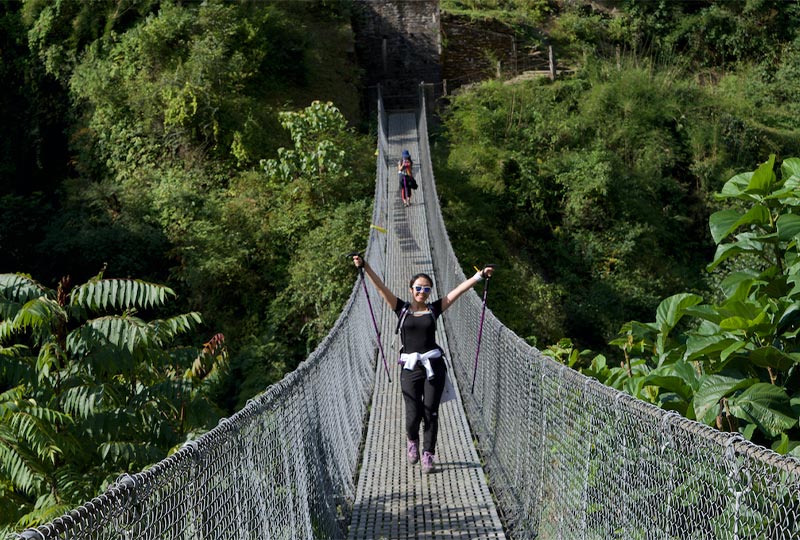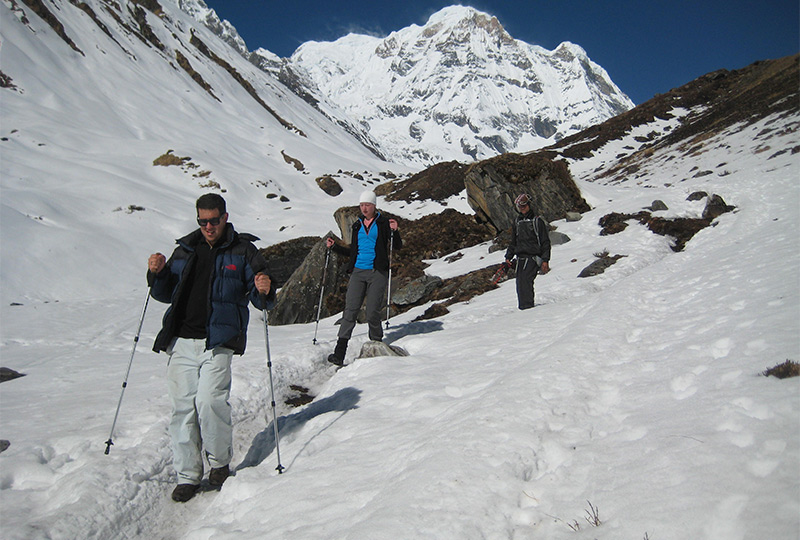Sitting in the lap of the Himalayas in the Annapurna Sanctuary, the trekking route leading to Annapurna Base Camp is one of Nepal’s most famous and thrilling trails. The gradually increasing elevation of Annapurna Base Camp, which reaches a maximum height of 4,130 meters (13,551 feet), offers you the adventure of a lifetime. During your journey, you will come across the stunning Annapurna region, passing through the foothills of Annapurna and Machhapuchhre.

Additionally, a plethora of enchanting views of intriguing terrains, remote valleys, glaciers, lush forests, and snow-topped mountains will make your trek worthwhile. The tiring trekking routes and rising elevation can make the trek challenging. However, proper preparations beforehand can save you from difficulties. Likewise, getting well acquainted with the altitude gain and elevation of the Annapurna Base Camp trekking route can help you learn what you are getting into.
- Annapurna Base Camp Elevation from Kathmandu
- Altitude Gain Data During ABC Trek
- Annapurna Base Camp Elevation Gain Chart
- Which Mountains Can You See from Annapurna Base Camp?
- Annapurna Base Camp Trek Comparison
- Annapurna Base Camp Trek Difficulties
- How to Prepare for Annapurna Base Camp Trek?
- Conclusion
Annapurna Base Camp Elevation from Kathmandu
Annapurna Base Camplies at the base of the world’s tenth tallest mountain, Annapurna which peaks all the way to the height of 8,091 meters (26,545 feet) from sea level. Regardless of the challenges of Annapurna Base Camp’s elevation, the famous trekking trail attracts hundreds of trekkers each year. If you are planning to explore the ABC trekking trails, we have an 11-day Annapurna Base Camp trek itinerary ready for you.
1. Kathmandu to Ghandruk
Your trip starts from Kathmandu at an altitude of 1,350 m (4,429 ft). After taking a flight from the Tribhuvan International Airport, the lush green landscape of Pokhara will welcome you at an elevation of 822 meters (2,597 feet). You will take a short drive to Kimche and then hike to Ghandruk, reaching the elevation of 1,940 m (6,365 ft) within an hour.

2. Ghandruk to Deurali
Following the scenic trails of Ghandruk, you will hike for 5-6 hours to the elevation of 2,170 m (7,120 ft) at Chhomrong village, famous for night stopover for the trekkers. After spending a night there, you will again ascend to Bamboo at 2,310 m (7,579 ft) altitude. Further, the elevation rises to 3,230 m (10,598 ft) after you hike for 3-4 hours from Bamboo to Deurali.
3. Deurali to Annapurna Base Camp
The rocky trails through Deurali leads you to Machhapuchhre Base Camp at an elevation of 3,700 meters (12,139 feet). After passing through the spectacular sight of Mt. Machhapuchhre from its base camp, you will reach the peak elevation of Annapurna Base Camp at 4,130 m (13,551 ft).
Then, you return through the same trail up to Bamboo, trek to Mathque and depart to Kathmandu via Pokhara Airport.
Altitude Gain Data During ABC Trek
This section presents a clear observation of altitude gain throughout the Annapurna Base Camp trek. In contrast to the above section, this tabular format helps you easily grasp the elevation of the ABC trekking trail.
| Location | Altitude |
| Kathmandu | 1,350 m (4,429 ft) |
| Pokhara | 822 m (2,597 ft) |
| Ghandruk | 1,940 m (6,365 ft) |
| Chhomrong | 2,170 m (7,120 ft) |
| Bamboo | 2,310 m (7,579 ft) |
| Deurali | 3,230 m (10,598 ft) |
| Machhapuchhre Base Camp | 3,700 m (12,139 ft) |
| Annapurna Base Camp | 4,130 m (13,551 ft) |
Annapurna Base Camp Elevation Gain Chart
The below-illustrated Annapurna Base Camp elevation chart will allow you to understand the elevation changes along the ABC trekking route from Kathmandu.

Which Mountains Can You See from Annapurna Base Camp?
One of the major attractions of the Annapurna Base Camp trek is witnessing numerous majestic snow-covered peaks visible from the base camp. And, the up-close sight of the alluring mountains surrounding ABC is worth the exhaustion of trekking over the rocky trails for days. Once you reach the peak elevation of Annapurna Base Camp, your gaze will land upon the breathtaking view of seven mighty mountains as mentioned below:
- Annapurna I (8,091 m/ 26,545 ft)
- Annapurna III (7,555 m/ 24,787 ft)
- Annapurna South (7,219 m/ 23,684 ft)
- Gangapurna (7,455 m/ 24,459 ft)
- Gandharva Chuli (6,248 m/ 20,499 ft)
- Himalchuli (6,816 m/ 22,362 ft)
- Macchapucchre (6,993 m/ 22,943 ft).
Usually, trekkers spend a night at the bowl-shaped base camp. The next morning you will wake up to a mesmerizing glimpse of the mountains glittering as the morning sunrays bounce off the snow-covered peaks surrounding ABC. Although you get a closer look at the mighty mountains from the Base Camp, you are followed by the sight of stunning mountains throughout your trek.
Annapurna Base Camp Trek Comparison
Besides Annapurna Base Camp trek, Nepal’s other renowned treks include the Annapurna Circuit trek, Everest Base Camp trek, Manaslu Circuit Trek, Annapurna Poonhill trek, and Kanchenjunga trek. Nepal, the land of the Himalayas, has all types of trekking routes ranging from moderate difficulty level to extreme. Therefore, the below-mentioned table is meant to shed light on the differences between some of the famous trekking trails in Nepal in terms of their altitude, the number of days, duration, and the level of difficulty.
| Trip Name | Trip Duration | Maximum Elevation | Difficulty level |
| Annapurna Base Camp Trek | 11 days | 4,130 m (13,551 ft) | Moderate |
| Annapurna Circuit Trek | 17 days | 5,416 m (17,770 ft) | Demanding |
| Annapurna Poon Hill Trek | 9 days | 3,210 m (10,532 ft) | Moderate |
| Everest Base Camp Trek | 16 days | 5,554 m (18,193 ft) | Demanding |
| Manaslu Circuit Trek | 18 days | 5,160m/16,930ft | Demanding |
| Kanchenjunga Trek | 25 days | 5,143 m (16,874 ft) | Demanding |
Annapurna Base Camp Trek Difficulties
The table mentioned above illustrates that the difficulty level of Annapurna Base Camp trek is fairly moderate in comparison to some of the other famous trekking routes in Nepal. However, the increasing elevation of Annapurna Base Camp trekking trail has its own challenges. Considered one of the famous treks in the Himalayas of Nepal, the ABC trek offers an exhilarating adventure. But, at times, the rocky trails can be demanding and might require that extra boost of effort and courage to pass through some of the countless challenging steep along the way.

The trek requires 11 days to finish from Kathmandu, with around 5-8 hours of hiking per day, so proper health condition makes your journey easier. Moreover, the trek covers a distance of 115 kilometers (71 miles), including 10 to 20 kilometers (6 to 12 miles) walk each day. Likewise, other difficulties of the Annapurna Base Camp trek include unpredictable weather conditions, altitude sickness, and a limited packing list. Although it seems quite challenging, with proper preparation beforehand, anyone can embark on their journey to ABC trek, enjoying mother nature’s serenity.
How to Prepare for Annapurna Base Camp Trek?
Despite the difficulties along the way through the rising altitude of Annapurna Base Camp trek, the trip is doable. In fact, it is an easier trek compared to other challenging trekking trails, and it is beginners friendly. Before you explore the nooks and corners of the ABC trekking trail, ensure you are in good health condition and make your body accustomed to daily mobility. As you have to walk through uphill and downhill trails, regular exercising is a must to prepare your body for the trek.

Likewise, keep your backpack as light as possible. Walking longer distances with heavy weight can lead you to exhaustion quickly. If you want to learn more about the packing list for Annapurna Base Camp trek,we have a perfect guide for you. Similarly, another major factor to consider during the ABC trek is altitude sickness. If not taken necessary precautions, altitude sickness can hamper your journey tremendously.
Symptoms and Prevention of Altitude Sickness
Generally, altitude sickness starts showing its effects after reaching an elevation of over 2,500 meters (8,202 feet). As you ascend the Himalayas, elevation gain constantly rises with uphill and downhill trails. The threat of altitude sickness starts kicking in once you cross Bamboo, sitting at an elevation of 2,310 meters (7,579 feet).
Some major symptoms of altitude sickness in the Himalayas include nausea, vomiting, dizziness, headache, fatigue, loss of appetite, and breathlessness. If you notice any of such symptoms, you must take necessary preventions and avoid the risk of its severity. You can take medications for your symptoms or take a break from the trek to minimize the risk. If the situation is severe, immediately stop your trip, rest where you are, and ask for medical attention from your guide or the organizer.
Conclusion
Preparing yourself before embarking on any trek can make your trip much easier. With the information about Annapurna Base Camp’s elevation detailed above, we hope you now have a better understanding of the landscapes you will encounter on your journey to ABC. If you have any further concerns or questions about the ABC trek, we have another article that answers some of the most frequently asked questions. Additionally, you can directly contact our experts for further queries about the ABC trek and plan your next trip with us. Stay connected with us on Facebook to learn more about our trip packages and travel updates!

Baburam is a young and vigorous person whose trekking journey has been in the mountainous region of Nepal comprising treks to EBC, ABC and many more. He has gathered immense knowledge of the mountainous terrains, local culture, traditions and other interesting aspects of adventurous journeys.






